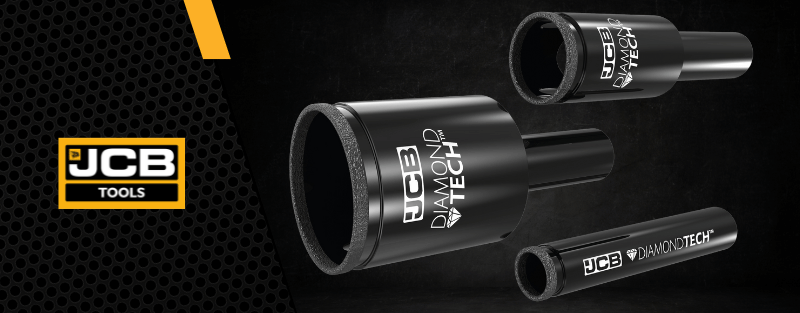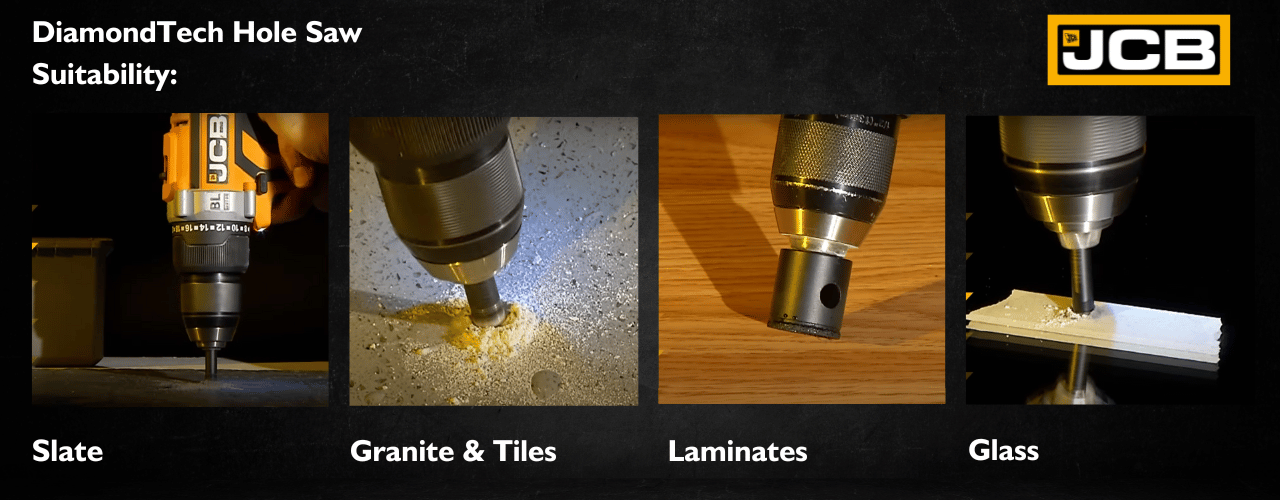JCB tools Complete Guide to Hole Saws
Posted by JCB Tools UK on 21st Jun 2023
Complete Guide to Hole Saws
Power Tool Guides | Drilling | Hole Saws | DiamondTeh | JCB Tools
Are you wondering what a hole saw is used for? In this comprehensive JCB Tools guide, we will delve into the world of hole saws and explore their various drilling applications. From JCB diamond-tipped hole saws to universal fit trade hole saws, we'll cover everything you need to know about these high-performance drilling tools. Whether you're a professional or a DIY enthusiast, JCB hole saws are essential additions to your toolbox.
 What is a Hole Saw Used for?
What is a Hole Saw Used for?
A hole saw, also known as a hole cutter, is a specialised drill bit designed to create larger circular holes than standard drill bits. These versatile drilling tools are widely used in various industries and applications. Different types of hole saw bits are available for materials like timber, plastics, metal, ceramics, masonry, glass, and more.
 What are Diamond Hole Saws?
What are Diamond Hole Saws?
Diamond tipped hole saws, also known as diamond core drill bits, are cutting tools specifically designed for harder materials such as stone, tile, glass, and ceramics. Unlike traditional hole saws with metal teeth, diamond hole saws feature a circular body embedded with diamond grit on the cutting edge. This section will explain how diamond hole saws work, their benefits, and why JCB Tools' DiamontTech offers professional-grade diamond hole saws for your drilling needs.
Unlike standard drill bits, hole saws are crafted to tackle larger holes with ease. When choosing a top-tier hole cutter, prioritise a combination of sturdy construction, premium materials, and precise machining to ensure optimal performance.
Well-crafted hole cutter bits possess relatively thin cylindrical walls in proportion to their internal diameter. This deliberate design reduces friction between the teeth and the work surface, resulting in reduced user effort when penetrating the material. Consequently, less strain is placed on the drill's motor during the drilling process.
The diameter of the created hole depends on the width of the hole saw you select. Typically, these holes are made in various types of sheet materials. However, hole saws are also available in different lengths, depths, and diameters. Opting for a deeper hole saw bit allows for clean and precise circular cuts even through relatively thick materials. It is essential to ensure that the drill being used is properly configured and capable of safely handling such materials.
To enhance versatility, many hole saws and kits include arbors or pilot drill bits as additional features. Additionally, these hole saws are compatible with standard arbors and other hole saw accessories. Some application-specific hole saw bits may offer additional optional features, such as:
✅Diamond tips for cutting ceramics and masonry materials.
✅Extra heavy-duty construction for challenging tasks or robust materials.
✅Carbide-tipped teeth ideal for fiberglass, formica, galvanized iron, and similar materials.
✅Extra thin kerfs (tooth thickness) for swift and effortless cutting.
✅A raised shoulder around the base of the hole cutter, designed to prevent over-drilling or breakthrough when it is not desired
 Tips for Using Hole Saws Effectively
Tips for Using Hole Saws Effectively
Using hole saws properly is essential for achieving precise and clean-cut holes. In this section, we'll provide valuable tips for using hole saws effectively.
✅ Ensure you use a drill with sufficient power for hole cutting. While cordless models may suffice for thinner or softer materials, a minimum of a 14V model is required, such the JCB 18v Combi Drill.. Avoid attempting to bore holes through masonry or heavier timber (over approximately 50mm) using a battery-operated drill, instead opt for a more powerful corded drill such has the JCB Corded Hammer Drill
✅Prioritise your safety by wearing suitable personal protective equipment (PPE) before using a hole saw. This should include appropriate goggles or glasses, a dust mask suitable for the material being cut, and high-quality work gloves. Avoid wearing loose clothing or accessories that can get caught in the hole saw, and securely tie back long hair.
Regardless of the material or surface you're working on, never force the drill bit to go faster than its natural pace. Apply gentle and consistent pressure to achieve a clean and perfectly round hole. Start slowly and gradually increase the rotation speed as you progress.
✅The specific design of the hole cutter often determines the maximum depth it can reach. The hollow core of the hole saw can accumulate removed material, eventually obstructing its descent beyond a certain depth. In such cases, use a screwdriver or similar tool to clear out the buildup. Some hole saws feature convenient "speed slots" in their side walls to aid in this process. Alternatively, you can purchase ejector springs as an aftermarket accessory. If no springs or clearout slots are available, lift the cutter away from the workpiece and manually empty the hollow core before continuing.
✅ Ensure you cut directly into the workpiece at an accurate perpendicular (90-degree) angle to the surface. This prevents binding, sticking, or overheating of the hole saw and the drill's motor. Be cautious as even a slightly off-center angle or hitting a nail while drilling can cause sudden and forceful binding or jamming of the drill.
✅ Before starting to drill, verify that the entire cutting edge of the hole saw makes even contact with the work surface all the way around. This ensures a smooth and efficient drilling process. When working with larger-bore holes in various sheeting and solid materials, it's advisable to use an arbor or pilot hole to prevent the hole cutter from sliding around during the initial stages of the cut. These pilot bits are usually adjustable or removable and sit at the center of the hole saw's hollow cylinder. They extend beyond the cutting end and may include an ejector spring mechanism.
✅ When drilling a hole through a workpiece, drilling directly from one side to the other with a hole saw can cause material tearing or "blowout" on the reverse side due to the width of the bit and the material being removed. To prevent this, wait until the pilot bit breaks through and then drill back from the rear side a few millimeters using the pilot hole as a guide. Return to the starting side and complete the full depth of the hole cut.
✅ In situations where you need to enlarge an existing smaller hole, such as when installing a new halogen downlight with a wider diameter than the previous one, it can be challenging to find a surface to cleanly start the cut. If accessible, clamping a scrap piece of timber behind the workpiece can provide a drilling surface for the pilot hole. Alternatively, a hole saw re-work adapter can be a useful accessory. It allows you to attach two different diameter hole saw bits simultaneously, with the smaller one acting as the guide or arbor bit (matching the existing hole width) and the larger attachment cutting a new, larger hole around it.
✅ Consider using a dust cowl accessory to cover the hole saw bit during use. These add-ons help prevent excessive debris spillage when drilling large holes and also protect the drill by preventing dust from entering the motor, especially when working overhead. Dust cowls accept the shank of the arbor through a central hole and flex as you drill, allowing better access to the work surface. They collect dirt and debris for easy disposal after drilling is complete.

 Applications and Types of Hole Saws
Applications and Types of Hole Saws
Hole saws have a wide range of applications in various industries and projects. In this section, we'll explore the different applications of hole saws.
When it comes to different applications and working environments, there is a wide range of hole cutters and hole saw accessories available. Some common applications include:
✅Drilling holes for cable routing and wiring runs.
✅Making cutouts in ceilings for downlights, fittings, or light fixtures.
✅Installing taps and hardware on sinks, baths, and worktops.
✅Joinery, woodworking, and DIY projects.
✅Fitting conduit runs or drainage pipes through kitchen units and walls.
✅Installing hardware for doors and cabinets, such as handles, locks, and rails.
✅Boring through masonry for ventilation or waste removal.
✅Hole saws for metal.
Hole saw cutters for sheet metals are designed to be extra robust and withstand the higher temperatures generated when cutting through common metals like stainless steel. To ensure longevity and cost-effectiveness, look for hole cutters with carbide-tipped teeth designed for metalworking. .
When working with wood, most multi-purpose or bi-metal hole saws will suffice. However, for efficient cutting of engineered woods like MDF, consider hole saws with carbide-tipped teeth. These teeth are typically used for metal cutting but can be beneficial when working with timber derivative materials that produce excessive dust, debris, or toxic fumes, especially as the temperature rises.For glass, ceramics, stone, brick, and concrete, hole cutters with gulleted or square teeth are commonly used. These teeth are set further apart compared to those on timber or plastic hole saws, providing more power for cutting harder or more abrasive surfaces. Keep in mind that these hole saws may result in slightly less neat holes.
Masonry hole saws, also known as "core drill bits," usually have widely spaced teeth, and some may even feature diamond-tipped teeth, such as the JCB DiamondTech for added hardness and cutting power. The wider spacing helps prevent clogging and binding, ensuring efficient material removal. "Variable pitch" hole saws with irregular tooth spacing can further reduce vibration, noise, and wear, though they may produce slightly rougher holes.
For ceramic tile, porcelain, glass, and masonry, toothless or "coated" hole saws are an alternative option. These hole saws have a flat rim coated with hard, abrasive materials like diamond or carbide instead of protruding teeth. The toothless design allows for neater and faster cuts in hard or dense materials with reduced risk of chipping or breaking. Water-cooling may be necessary due to increased friction and heat generation.
 Discover JCB Drill Bits and Hole Saws
Discover JCB Drill Bits and Hole Saws
We hope you’ve found these tips helpful and remember: if you need any further advice, our team of experts is on-hand to help you, so just get in touch! If you have any questions please visit www.jcb-tools.co.uk/contact-us For expert advice or any questions you may have, you can give us a call on 01646 687 880, fill out the contact form here or drop us a message on any of our social media pages - Facebook, Instagram or Twitter.







